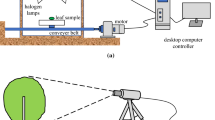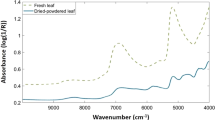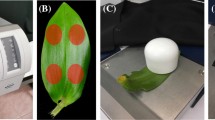Abstract
Early diagnosis of specific chloride toxicity in persimmon trees requires the reliable and fast determination of the leaf chloride content, which is usually performed by means of a cumbersome, expensive and time-consuming wet analysis. A methodology has been developed in this study as an alternative to determine chloride in persimmon leaves using near-infrared spectroscopy (NIRS) in combination with multivariate calibration techniques. Based on a training dataset of 134 samples, a predictive model was developed from their NIR spectral data. For modelling, the partial least squares regression (PLSR) method was used. The best model was obtained with the first derivative of the apparent absorbance and using just 10 latent components. In the subsequent external validation carried out with 35 external data this model reached r 2 = 0.93, RMSE = 0.16 % and RPD = 3.6, with standard error of 0.026 % and bias of −0.05 %. From these results, the model based on NIR spectral readings can be used for speeding up the laboratory determination of chloride in persimmon leaves with only a modest loss of precision. The intermolecular interaction between chloride ions and the peptide bonds in leaf proteins through hydrogen bonding, i.e. N–H···Cl, explains the ability for chloride determinations on the basis of NIR spectra.

The NIRS-PLSR alternative to the wet reference analytical method for chloride determination in persimmon leaves saves lab work in exchange of a modest loss of precissionᅟ




Similar content being viewed by others
Abbreviations
- A :
-
Apparent absorbance
- DW:
-
Dry weight
- K-S:
-
Kolmogorov-Smirnov
- LC:
-
Latent component
- MLR:
-
Multiple linear regression
- NIR:
-
Near-infrared
- NIRS:
-
Near-infrared spectroscopy
- PC:
-
Principal component
- PCA:
-
Principal components analysis
- PCR:
-
Principal components regression
- PLSR:
-
Partial least squares regression
- r :
-
Pearson’s product-moment correlation coefficient
- r 2 :
-
Coefficient of determination
- R :
-
Diffuse reflectance
- RMSE:
-
Root mean square error
- RPD:
-
Ratio of standard error of performance to standard deviation
- SD:
-
Standard deviation
References
Grundon NJ, Robson AD, Lambert MJ, Snowball K. Nutrient deficiency and toxicity symptoms. In: Reuter DJ, Robinson JB, Dutkiewicz C, editors. Plant analysis: an interpretation manual. Collingwood: CSIRO; 1997. p. 37–51.
Marschner H. Mineral nutrition of higher plants. 2nd ed. London: Academic; 1995.
Edwards IK, Kalra YP, Radford FG. Chloride determination and levels in the soil-plant environment. Environ Pollut Series B Chem Phys. 1981;2:109–17.
White PJ, Broadley MR. Chloride in soils and its uptake and movement within the plant: a review. Ann Bot. 2001;88:967–88.
Xu G, Magen H, Tarchitzky J, Kafkafi V. Advances in chloride nutrition. Adv Agron. 2000;68:96–150.
Ayers RS, Westcot DW. Water Quality for Agriculture. Irrig Drain Paper Paper 29, Rev. 1. Rome: FAO; 1985.
Visconti F, de Paz JM, Bonet L, Jordà M, Quiñones A, Intrigliolo DS. Effects of a commercial calcium protein hydrolysate on the salt tolerance of Diospyros kaki L. cv. “Rojo Brillante” grafted on Diospyros lotus. Sci Hortic. 2015;185:129–38.
George A, Nissen B, Broadley R. Persimmon nutrition: a practical guide to improving fruit quality and production. Camberwell: Queensland Horticulture Institute; 2005.
de Paz JM, Visconti F, Tudela L, Quiñones A, Intrigliolo D, Jordà M, Bonet L. La fitotoxicidad por cloruro en el cultivo del caqui: Descripción del problema. Agrícola Vergel (in press). 2016.
Besada C, Gil R, Bonet L, Quiñones A, Intrigliolo D, Salvador A. Chloride stress triggers maturation and negatively affects the postharvest quality of persimmon fruit. Involvement of calyx ethylene production. Plant Physiol Biochem. 2016;100:105–12.
FAO (2015) FAOSTAT database—Food and Agriculture Organization of the United Nations (FAO), Rome. http://faostat3.fao.org/home/E. Accessed 6 Apr 2015.
Ercisli S, Akbulut M. Persimmon cultivation and genetic resources in Turkey. Acta Horticulturae (ISHS). 2009;833:35–8.
Miller RO. Extractable chloride, nitrate, orthophosphate, potassium, and sulfate-sulfur in plant tissue: 2% acetic acid extraction. In: Kalra YP, editor. Handbook of reference methods for plant analysis. Boca Raton: CRC Press; 1998. p. 115–8.
Chang CW, Laird DA. Near-infrared reflectance spectroscopic analysis of soil C and N. Soil Sci. 2002;167:110–6.
Morra MJ, Hall MH, Freeborn LL. Carbon and nitrogen analysis of soil fractions using near-infrared reflectance spectroscopy. Soil Sci Soc Am J. 1991;55:288–91.
Cozzolino D. Near infrared spectroscopy in natural products analysis. Planta Med. 2009;75:746–56.
Begley TH, Lanza E, Norris KH, Hruschka WR. Determination of sodium chloride in meat by near-infrared diffuse reflectance spectroscopy. J Agric Food Chem. 1984;32:984–7.
Shao XG, Ning Y, Liu FX, Li JH, Cai WS. Application of near-infrared spectroscopy in micro inorganic analysis. Acta Chim Sin. 2012;70:2109–14.
van Maarschalkerweerd M, Bro R, Egebo M, Husted S. Diagnosing latent copper deficiency in intact barley leaves (Hordeum vulgare, L.) using near infrared spectroscopy. J Agric Food Chem. 2013;61:10901–10.
Guo ZM, Zhao CJ, Huang WQ, Wang YA, Guo JH. Nondestructive quantification of foliar chlorophyll in an apple orchard by visible/near-infrared reflectance spectroscopy and partial least squares. Spectr Lett. 2014;47:481–7.
Tobias RD. An introduction to partial least squares regression. SAS Global Forum Proceedings/SUGI 95. 1995. pp 1250–1257.
Wold S, Martens H, Wold H. The multivariate calibration problem in chemistry solved by the PLS method. Matrix Pencils. 1983;973:286–93.
Viscarra-Rossel RA, Behrens T. Using data mining to model and interpret soil diffuse reflectance spectra. Geoderma. 2010;158:46–54.
Viscarra-Rossel RA. ParLeS: software for chemometric analysis of spectroscopic data. Chemom Intell Lab Syst. 2008;90:72–83.
Jolliffe IT. Principal component analysis. London: Springer; 2002.
Martens H, Næs T. Multivariate calibration. Chichester: Wiley; 1989.
Gilliam JW. Rapid measurement of chlorine in plants materials. Soil Sci Soc Am Proc. 1971;35:512–3.
Cotlove E. Determination of the true chloride content of biological fluids and tissues. II. Analysis by simple, nonisotopic methods. Anal Chem. 1963;35:101–5.
Williams PC. Implementation of near-infrared technology. In: Williams PC, Norris KH, editors. Near-infrared technology in the agricultural and food industry. 2nd ed. St. Paul: American Association of Cereal Chemists; 2001. p. 8.
Fearn T. Assessing calibrations: SEP, RPD, RER and R2. NIR News. 2002;13:12–4.
Elvidge DE. Visible and near infrared reflectance characteristics of dry plant materials. Int J Remote Sens. 1990;11:1775–95.
Rotbart N, Schmilovitch Z, Cohen Y, Alchanatis V, Erel R, Ignat T, et al. Estimating olive leaf nitrogen concentration using visible and near-infrared spectral reflectance. Biosyst Eng. 2013;114:426–34.
Dalal RC, Henry RJ. Simultaneous determination of moisture, organic carbon, and total nitrogen by near infrared reflectance spectrophotometry. Soil Sci Soc Am J. 1986;50:120–3.
Shi T, Cui L, Wang J, Fei T, Chen Y, Wu G. Comparison of multivariate methods for estimating soil total nitrogen with visible/near-infrared spectroscopy. Plant Soil. 2013;366:363–75.
Slama I, Abdelly C, Bouchereau A, Flowers T, Savouré A. Diversity, distribution and roles of osmoprotective compounds accumulated in halophytes under abiotic stress. Ann Bot. 2015;115:433–47.
Workman J, Weyer L. Practical guide and spectral atlas for interpretive near-infrared spectroscopy. Boca Raton: CRC Press; 2012.
Jadhav NH, Kashid DN, Kulkarni SR. Subset selection in multiple linear regression in the presence of outlier and multicollinearity. Stat Methodol. 2014;19:44–59.
Acknowledgments
The funding for this work was provided by the Spanish “Ministerio de Ciencia e Innovación” through project CGL2012-39725-C02, and locally funding by the “San Bernat” agricultural cooperative of Carlet (Valencia-Spain). F. Visconti thanks the financial support received from the “Ministerio de Economía y Competitividad” through grant “Juan de la Cierva” (JCI-2011-11254). We would also like to thank the comments, indications and suggestions of the anonymous reviewers and editor that were of much help to improve the article.
Author information
Authors and Affiliations
Corresponding authors
Ethics declarations
Conflict of interest
The authors do not have any conflict of interest regarding the results and interpretations communicated in this article. Besides, product identifications in this chapter have been provided for the benefit of the readers and do not imply any endorsement of the authors, nor their institutions.
Rights and permissions
About this article
Cite this article
de Paz, J.M., Visconti, F., Chiaravalle, M. et al. Determination of persimmon leaf chloride contents using near-infrared spectroscopy (NIRS). Anal Bioanal Chem 408, 3537–3545 (2016). https://doi.org/10.1007/s00216-016-9430-2
Received:
Revised:
Accepted:
Published:
Issue Date:
DOI: https://doi.org/10.1007/s00216-016-9430-2




